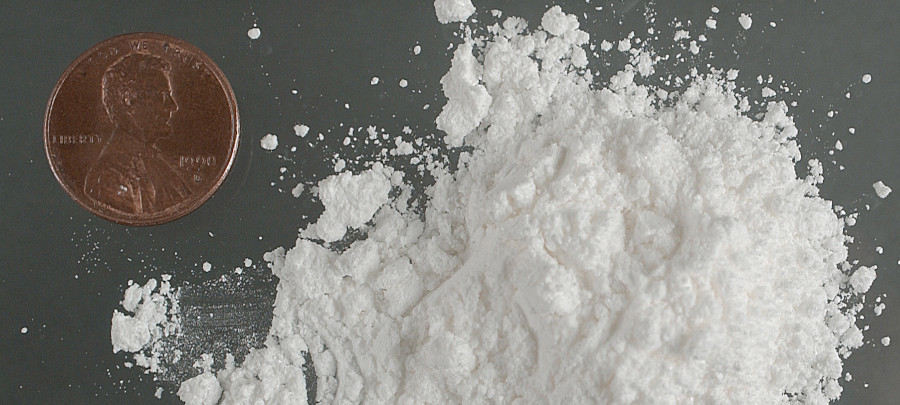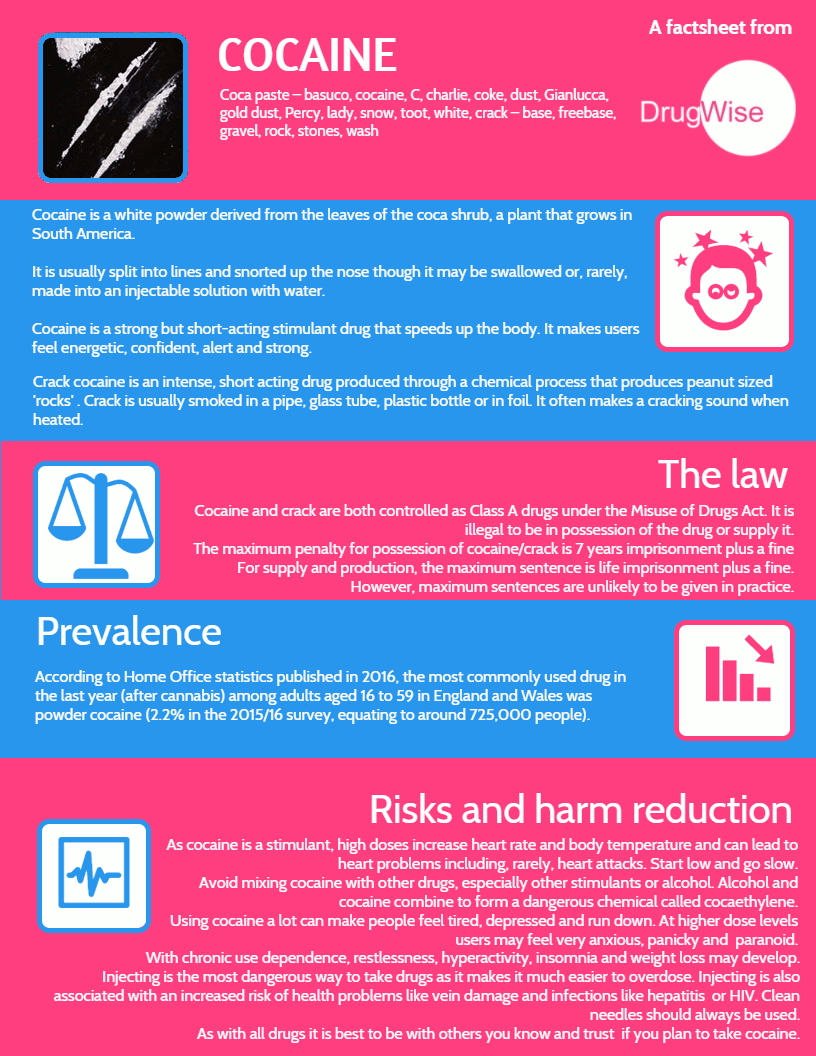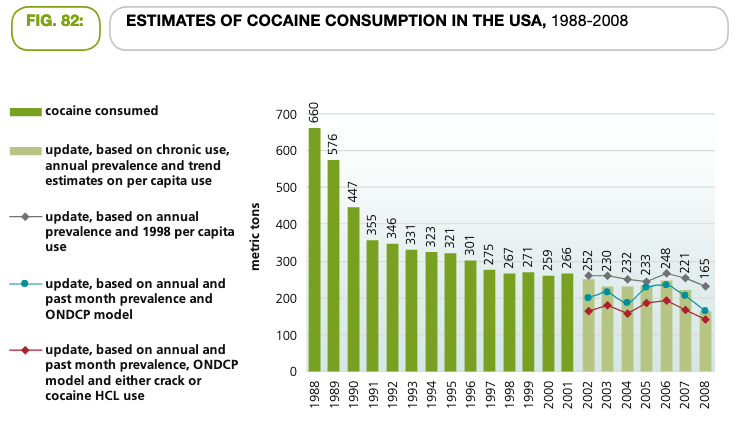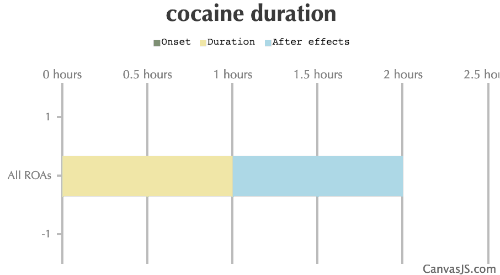[ Home ] [ Controlled Substances ] [ Stimulants ]
COCAINE
|

Cocaine
Cocaine is an alkaloid ester extracted from the leaves of plants including coca. Cocaine is a local anesthetic and vasoconstrictor and is clinically used for that purpose, particularly in the eye, ear, nose, and throat. It also has powerful central nervous system effects similar to the amphetamines and is a drug of abuse. Cocaine, like amphetamines, acts by multiple mechanisms on brain catecholaminergic neurons; the mechanism of its reinforcing effects is thought to involve inhibition of dopamine uptake.Cocaine is addictive due to its effect on the reward pathway in the brain. After a short period of use, there is a high risk that dependence will occur. Its use also increases the risk of stroke, myocardial infarction, lung problems in those who smoke it, blood infections, and sudden cardiac death.
Cocaine sold on the street is commonly mixed with local anesthetics, cornstarch, quinine, or sugar which can result in additional toxicity. Following repeated doses, a person may have decreased the ability to feel pleasure and be very physically tired. Cocaine acts by inhibiting the reuptake of serotonin, norepinephrine, and dopamine. This results in greater concentrations of these three neurotransmitters in the brain. It can easily cross the blood-brain barrier and may lead to the breakdown of the barrier.
Powdered cocaine (cocaine hydrochloride) is a stimulant that is extracted from the leaves of the coca plant, which is native to South America. In the late 19th century cocaine was used as an anesthetic, but the availability of safer drugs rendered many of its medical applications obsolete. Today powdered cocaine is abused for the intense euphoric effects it produces.


https://www.justice.gov/archive/ndic/pubs3/3951/3951p.pdf
What is cocaine?
On the street it is usually sold as a fine, white powder. The powdered, hydrochloride salt form can be snorted or dissolved in water and injected. Use in any form is illegal in the U.S. when used as recreational drug.Freebase is cocaine hydrochloride that is processed with ammonia and heated to remove the hydrochloride salt. This 'freebase' form is not water-soluble; the powder can be heated and its vapors smoked due to the lower melting point. Diethyl ether is used to process freebase and is highly flammable and volatile, often leading to lab explosions and bodily injury such as burns. It produces a much more intense "rush" than snorting the drug and can be extremely addictive due to the quick high and repeated use. People who use this drug in any form may binge to maintain their high.
Crack cocaine is another form that is processed into a rock form using baking soda and may contain a high percentage of impurities.
The term "crack" refers to the crackling sound heard when it is heated prior to smoking.
Crack abuse in the U.S. rose in the mid-1980's and is considered the most addictive form of the drug.Most often the powder is snorted, and the drug is laid out on a mirror, plate or other flat surface, separated into 'lines' and snorted nasally through a straw, rolled-up dollar bill or other inhaling device. The cocaine is absorbed into the bloodstream through the nasal tissues. The effect, or 'high' with snorting may last 15 to 30 minutes, but does not occur as quickly as smoking or injecting it. Alternatively, smoking crack or injecting cocaine may have a rapid and more intense effect, but the 'high' only lasts 5 to 10 minutes, often with an intense "crash", which leads to repeated use to sustain the high, an action called 'binging'.
How is cocaine used medically?
Cocaine is available in the U.S. as a prescription solution for local mucosal anesthesia, and for some eye, ear, and throat surgeries, but is infrequently used because of safer alternatives, such as lidocaine or benzocaine. A nasal solution is used for the induction of local anesthesia of the mucous membranes when performing diagnostic procedures and surgeries on or through the nasal cavities in adults. Topical cocaine may be administered by using cotton applicators or packs, installed into a cavity, or as a spray.Brands names for FDA-approved topical cocaine solution products include Goprelto and Numbrino.
 Excerpt from Drugs.com:
Excerpt from Drugs.com:
https://www.drugs.com/illicit/cocaine.html
Cocaine is a powerfully addictive stimulant drug made from the leaves of the coca plant native to South America.
- Street dealers often mix it with things like cornstarch, talcum powder, or flour to increase profits.
- They may also mix it with other drugs such as the stimulant amphetamine or the synthetic opioid fentanyl.
- People snort cocaine powder through the nose, or rub it into their gums. Others dissolve the powder and inject it into the bloodstream, or inject a combination of cocaine and heroin, called a Speedball. Another popular method of use is to smoke Crack cocaine.
- Cocaine increases levels of the natural chemical messenger dopamine in brain circuits related to the control of movement and reward.
- A person can overdose on cocaine, which can lead to death.
- Behavioral therapy may be used to treat cocaine addiction.
- While no government-approved medicines are currently available to treat cocaine addiction, researchers are testing some treatments that have been used to treat other disorders.


https://www.questdiagnostics.com/home/physicians/health-trends/drug-testing/map_cocaine/
Cocaine is usually distributed as a white, crystalline powder. Cocaine is often diluted ("cut") with a variety of substances, the most common of which are sugars and local anesthetics. It is "cut" to stretch the amount of the product and increase profits for dealers. In contrast, cocaine base (crack) looks like small, irregularly shaped chunks (or "rocks") of a whitish solid. Powdered cocaine can be snorted or injected into the veins after dissolving in water. Cocaine base (crack) is smoked, either alone or on marijuana or tobacco. Cocaine is also used in combination with an opiate, like heroin, a practice known as "speedballing." Although injecting into veins or muscles, snorting, and smoking are the common ways of using cocaine, all mucous membranes readily absorb cocaine. Cocaine users typically binge on the drug until they are exhausted or run out of cocaine.
Following smoking or intravenous injection, cocaine reaches the brain in seconds, with a rapid buildup in levels. This results in a rapid-onset, intense euphoric effect known as a "rush." By contrast, the euphoria caused by snorting cocaine is less intense and does not happen as quickly due to the slower build-up of the drug in the brain. Other effects include increased alertness and excitation, as well as restlessness, irritability, and anxiety. Tolerance to cocaine's effects develops rapidly, causing users to take higher and higher doses. Taking high doses of cocaine or prolonged use, such as binging, usually causes paranoia. The crash that follows euphoria is characterized by mental and physical exhaustion, sleep, and depression lasting several days. Following the crash, users experience a craving to use cocaine again.
Chronic snorting of cocaine leads to the erosion of the upper nasal cavity.


https://www.dea.gov/sites/default/files/2018-06/drug_of_abuse.pdf#page=51
History of Cocaine:
Early Spanish explorers noticed how the native people of South America were able to fight off fatigue by chewing on coca leaves. A medical account of the coca plant was published in 1569. In 1860, Albert Neiman isolated cocaine from the coca leaf and described the anesthetic action of the drug when it was put on his tongue. Angelo Mariani, in the early 1880s produced a "medicinal" wine, called Vin Mariani, that contained 11% alcohol and 6.5 mg of cocaine in every ounce. The famous psychotherapist, Sigmund Freud, in 1884, recommended cocaine for a variety of illnesses and for alcohol and morphine addictions. Unfortunately, many of his patients went on to become addicted to cocaine! In 1886, John Pemberton developed Coca Cola, a drink that contained cocaine and caffeine. Cocaine was REMOVED from Coca Cola in 1906 (but it still has the caffeine). The Harrison Narcotic Act in 1914 made cocaine illegal. Finally, in 1985, crack cocaine was introduced and rapidly became a major drug problem.
 History of Cocaine:
History of Cocaine:
http://faculty.washington.edu/chudler/coca.html
Cocaine is one of the most dangerous drugs known to man. Once a person begins taking the drug, it has proven almost impossible to become free of its grip physically and mentally. Physically it stimulates key receptors (nerve endings that sense changes in the body) within the brain that, in turn, create a euphoria to which users quickly develop a tolerance. Only higher dosages and more frequent use can bring about the same effect. It is most often sniffed, with the powder absorbed into the bloodstream through the nasal tissues. It can also be ingested or rubbed into the gums. To more rapidly absorb the drug into the body, abusers inject it, but this substantially increases the risk of overdose. Inhaling it as smoke or vapor speeds absorption with less health risk than injection.
Today, cocaine is a worldwide, multi-billion dollar enterprise. Users encompass all ages, occupations and economic levels, even schoolchildren as young as eight years old.
Cocaine use can lead to death from respiratory (breathing) failure, stroke, cerebral hemorrhage (bleeding in the brain) or heart attack. Children of cocaine addicted mothers come into the world as addicts themselves. Many suffer birth defects and many other problems.
Despite its dangers, cocaine use continues to increase - likely because users find it so difficult to escape from the first steps taken down the long dark road that leads to addiction.

https://www.drugfreeworld.org/drugfacts/cocaine.html
- Cocaine is a short-acting stimulant and takes effect by increasing the amount of neurotransmitters (brain chemicals) such as dopamine, serotonin and norepinephrine. Cocaine is produced from the leaves of the coca plant, which is native to South America.
- When snorted or injected, cocaine quickly produces an intense 'rush', with the purity and the amount of the drug taken determining its intensity. The rush doesn't last very long usually only 30-45 minutes, if snorted.
- Cocaine is a very unpredictable drug. Toxic (and sometimes fatal) reactions can occur regardless of the amount used, whether the person is a first-time, occasional or regular user. Mixing drugs causes additional problems.
- The most serious physical consequence of cocaine use concerns the heart and the risk of stroke. Cocaine may cause heart attacks by a combination of increasing oxygen demand, constriction of the coronary arteries and enlargement of the heart.
- One major harm associated with regular cocaine use is the development of a cocaine-induced paranoid psychosis.
- There is no proven drug treatment for cocaine dependence.


https://ndarc.med.unsw.edu.au/sites/default/files/ndarc/resources/NDA073%20Fact%20Sheet%20Cocaine.pdf
Cocaine Factsheet:


https://www.drugwise.org.uk/cocaine-and-crack/
"Cocaine" comprises at least two distinct drug products: powder cocaine on the one hand, and a range of cocaine base products, mostly falling under the heading of "crack", on the other. Powder cocaine is a milder drug generally snorted by the wealthy, while crack and other base products present an intense high favoured by the poorer users. Chemically, the substance consumed is the same, but the addition of baking soda and heat allows cocaine to be smoked, a far more direct method of ingestion. Both products are derived from a plant cultivated on some 170,000 hectares in remote areas of Colombia, Peru and the Plurinational State of Bolivia. From there, cocaine is distributed to at least 174 countries around the world.



https://www.unodc.org/documents/data-and-analysis/tocta/4.Cocaine.pdf
Liver:
High doses of cocaine can be associated with toxic reactions including hyperthermia, rhabdomyolysis, shock and acute liver injury which can be severe and even fatal.
Cocaine Hepatotoxicity:
Cocaine has many serious medical consequences including cardiac arrhythmias, coronary artery spasm and myocardial infarction, cerebrovascular accidents, subarachnoid hemorrhage, seizures, hallucinations, intestinal ischemia, renal infarction, rhabdomyolysis and acute liver injury. Cocaine is a not infrequent cause of sudden "unexplained" death in young adults. Hepatotoxicity usually arises hours to a few days after an acute overdose, generally following or accompanying other major organ involvement. The clinical phenotype of cocaine hepatototoxicity is usually acute hepatic necrosis. Initially, serum aminotransferase and LDH levels are markedly elevated with minimal increase in alkaline phosphatase. The prothrombin time becomes abnormal rapidly and may also reflect disseminated intravascular coagulation (DIC). The serum bilirubin begins to rise after 2 to 3 days. Immunoallergic features and autoantibodies are usually absent. Liver histology usually shows centrolobular (zone 3) necrosis and fatty change, features that resemble ischemic hepatitis or liver injury due to hyperthermia, factors that may partially mediate the hepatotoxic effects of cocaine. In self-limited cases, recovery is rapid and serum aminotransferase levels usually return to normal within 1 to 2 weeks.A [HD] Likelihood score: A[HD] (well known cause of acute liver injury, but only when taken as an overdose).
 Cocaine Overview:
Cocaine Overview:
https://www.ncbi.nlm.nih.gov/books/NBK548454/
Breastfeeding:Summary of Use During Lactation:
No data are available on the medical use of cocaine in nursing mothers. However, because of its chemical nature, high concentrations of cocaine are expected in milk.Cocaine and its metabolites are detectable in breastmilk, although data are from random breastmilk screening of mothers who used cocaine recreationally rather than controlled studies.
Cocaine breastmilk concentrations have varied over 100-fold in these reports.Newborn infants are extremely sensitive to cocaine because they have not yet developed the enzyme that inactivates it and serious adverse reactions have been reported in a newborn infant exposed to cocaine via breastmilk.
Cocaine should not be used by nursing mothers or smoked (such as with "crack") by anyone in the vicinity of infants because the infants can be exposed by inhaling the smoke.
Other factors to consider are the possibility of positive urine tests in breastfed infants which might have legal implications, and the possibility of other harmful contaminants in street drugs. A breastfeeding abstinence period of 24 hours has been suggested for women who occasionally use cocaine while breastfeeding, based on the rapid elimination of cocaine by the mother. Some authors have proposed that breastfeeding be discontinued only for those infants who test positive for cocaine exposure. However, the Academy of Breastfeeding Medicine suggests that women who have abused cocaine generally should not breastfeed unless they have a negative maternal urine toxicology at delivery, have been abstinent for at least 90 days, are in a substance abuse treatment program and plan to continue it in the postpartum period, have the approval of their substance abuse counselor, have been engaged and compliant in their prenatal care, and have no other contraindications to breastfeeding.Drug Levels:
Propoxyphene is metabolized to active norpropoxyphene (25%) and to several inactive metabolites.Norpropoxyphene has a 30 to 36 hour half-life.
The oral bioavailability of norpropoxyphene is unknown. Propoxyphene is available in 2 salt forms: 65 mg of the hydrochloride form is equivalent to 100 mg of the napsylate.Effects on Lactation and Breastmilk:
Long-term cocaine use can result in chronic, low-level hyperprolactinemia.The prolactin level in a mother with established lactation may not affect her ability to breastfeed.
Mothers who use cocaine initiate breastfeeding of their infants less frequently than mothers who do not use cocaine.
 Cocaine Drug Levels and Effects:
Cocaine Drug Levels and Effects:
https://www.ncbi.nlm.nih.gov/books/NBK501588/
| Duration: A highly popular, short acting CNS stimulant that works by blocking the reuptake of dopamine, serotonin, and norepinephrine. It is known to increase euphoria, confidence, sex-drive, focus, body temperature, and heart rate. Cocaine can cause severe vasoconstriction and is known to be cardiotoxic and have a high potential for compulsive redosing and addiction. | |||
| Route | Onset | Duration | After Effects |
|---|---|---|---|
| Tripsit Factsheets | |||

Cocaine Basic Information: http://drugs.tripsit.me/cocaine | |||
| All ROAs: | Rapid. | 1-1.5 hours | 1-4 hours |

| |||
Detection:
| |||
| Marquis: Clear (No change) | |||
Aliases:
| |||
| Effects: Elevated mood. Increase in irritability, hyper-inflated ego, euphoria, stimulation, raised heartrate, numbing effects depending on ROA, nausea (particularly at high doses) | |||

https://erowid.org/experiences/subs/exp_Cocaine.shtml

https://erowid.org/experiences/subs/exp_Crack.shtml


https://www.justice.gov/archive/ndic/pubs3/3978/3978p.pdf

http://www.cesar.umd.edu/cesar/drugs/cocaine.pdf


https://www.ncbi.nlm.nih.gov/pmc/articles/PMC1297313/pdf/jrsocmed00006-0013.pdf


https://files.ondemandhosting.info/data/www.drugfreeworld.org/files/truth-about-cocaine-booklet-en.pdf


http://www.drugs.ie/resourcesfiles/ResearchDocs/Europe/Research/2007/TDSI07002ENC.pdf


http://www.emcdda.europa.eu/system/files/publications/10225/2018-cocaine-trendspotter-rapid-communication.pdf


https://deamuseum.org/wp-content/uploads/2018/03/022118__DEAMuseum__Cocaine__PPT.pdf

https://drugs-forum.com/forums/cocaine-crack.22/

https://www.reddit.com/r/cocaine/
My dealer told me my coke is pure. Is it? No. If you are in any country outside of South America, there is a 100% chance your cocaine is not going to be pure.
IMPORTANT NOTICE:
Cocaine speeds up your whole body. You may feel full of energy, happy, and excited. But then your mood can change. You can become angry, nervous, and afraid that someone's out to get you. You might do things that make no sense. After the "high" of the cocaine wears off, you can "crash" and feel tired and sad for days. You also get a strong craving to take the drug again to try to feel better. No matter how cocaine is taken, it is dangerous. Some of the most common serious problems include heart attack and stroke. You are also at risk for HIV/AIDS and hepatitis, from sharing needles or having unsafe sex. Cocaine is more dangerous when combined with other drugs or alcohol. It is easy to lose control over cocaine use and become addicted. Then, even if you get treatment, it can be hard to stay off the drug. People who stopped using cocaine can still feel strong cravings for the drug, sometimes even years later.
 Medlineplus Cocaine:
Medlineplus Cocaine:
https://medlineplus.gov/cocaine.html
Cocaine:
Cocaine is the second most frequently used illegal drug globally, after cannabis. Use is highest in North America followed by Europe and South America.
With further processing, crack cocaine can be produced from cocaine.
- A strong stimulant
- Most frequently used as a recreational drug
- It is commonly snorted, inhaled as smoke, or dissolved and injected into a vein.
- Mental effects may include an intense feeling of happiness, sexual arousal, loss of contact with reality, or agitation.
- Physical symptoms may include a fast heart rate, sweating, and large pupils.
- High doses can result in very high blood pressure or body temperature.
- Effects begin within seconds to minutes of use and last between five and ninety minutes.
- Cocaine is addictive due to its effect on the reward pathway in the brain. After a short period of use, there is a high risk that dependence will occur.
Cocaine was first isolated from the leaves in 1860
Cocaine has a small number of accepted medical uses, such as numbing and decreasing bleeding during nasal surgery.
Cocaine sold on the street is commonly mixed with local anesthetics, cornstarch, quinine, or sugar, which can result in additional toxicity.
Sarasota cops seize 666 grams of cocaine in drug bust - Sarasota Police seized more than 600 grams of cocaine and arrested a man suspected of drug trafficking during a search warrant execution, the department announced Wednesday morning. Wednesday December 17, 2025 - usatoday.com Colombia’s Cocaine Smugglers Employ a Deadly New Weapon—Drones - Drone attacks by resurgent militias are battering the country’s strained security services as they grow in frequency and ferocity. Police seize 232 small bags of suspected crack cocaine in Manassas City drug bust - Manassas City Police Special Problems Unit were investigating a narcotics case at 8600 block of Bruton Parish Court. Before officers arrived, they noticed a wanted person, 30-year-old Alexis Smith on ... Raleigh Man Sentenced to 15 Years for Fentanyl, Cocaine, and Meth Trafficking - In a recent development out of Raleigh, a man has been handed a hefty 15year federal sentence following his guilty plea for trafficking fentanyl, cocaine, and methamphetamine. Joshua McClain, a ... What is the recreational drug 'pink cocaine'? - This photo provided by the Office of the Special Narcotics Prosecutor in New York shows a bag of pink cocaine in January 2023. (Office of the Special Narcotics Prosecutor in New York via AP) A ... Cocaine production is at record-high levels, UN says, but drug interceptions mean that less is actually available on the streets - Cocaine production is at record levels, with demand for the drug rebounding after temporarily slumping amid the pandemic, according to the UN. Five guns, cash, and cocaine: Massachusetts duo sentenced for running drugs in Vermont - Two men from Springfield, Massachusetts, have been sentenced to five years in federal prison for operating a drug trafficking ring armed with handguns in Rutland County. On Monday, Chief U.S. District ... Organized Crime Drug Interdiction Task Forces seize more than $75 million in narcotics in 2025 - COLUMBUS — Law enforcement task forces established under the Ohio Organized Crime Investigations Commission (OOCIC) thwarted drug traffickers in 2025 by confiscating more than $75 million worth of ... Cannabidiol may prevent sensitization to cocaine and caffeine by influencing brain structure genes - A new study published in the journal Addiction Neuroscience provides evidence that cannabidiol may help prevent the heightened behavioral response associated with the combined use of cocaine and ... Killing for cocaine: Inside evasive drug queen Griselda Blanco's reign of terror that came to an ironic end - Ruthless and brutal "Cocaine Godmother" Griselda Blanco became the world's most unlikely drug lord, commanding a crew that shipped thousands of pounds of cocaine into the U.S. every month, leading an ... What Is Pink Cocaine, the Drug Seized During Sean ‘Diddy’ Combs’ Arrest? - When authorities raided Sean “Diddy” Combs’ hotel room, they discovered a drug called pink cocaine, or pink ketamine. The drug is bright pink in color and has been linked to other celebrities in ...
| ||
| Stimulants | Link to this page |









